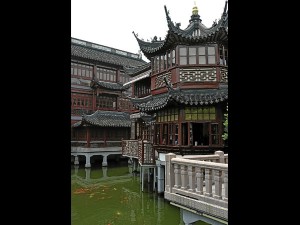
LAYERED black, tiled roofs, curved eaves, animal décor, white walls and lattice woodwork recreate the feel of what could have truly been old Shanghai.
It was a trip that I had been yearning to do—to Shanghai that is. Despite having done design work in that city, I had never had the chance to be there myself. Unfortunately, someone who spoke the language always went on my behalf. Then I thought I’d have the opportunity to go during the Shanghai expo, but my schedules were tight. This summer, that window to Shanghai had finally opened!
I have always been mystified by Shanghai. To me, the name connotes stories of east meeting west, exotic sights and wild adventures in foreign land, just as many movies had portrayed it. Well, my visit was quite tame in comparison. With husband and children in tow, it was instead a wholesome and fun-filled holiday.
Colonial buildings
One of the attractions I enjoyed was “the Bund,” that strip of colonial buildings that line the west bank of the Huangpu River which was, during Shanghai’s heyday, a bustling commercial hub. As the French, Japanese, American and British successfully occupied various parts of the city, they established these buildings as offices to support their main line of business which then was largely trading. The structures in the Bund are quite an assortment, with their architectural styles ranging from Gothic, Baroque, Romanesque, Classicism, the Renaissance and Art Deco. In the evenings, they are beautifully lit, showcasing the diversity of their designs. The Bund is quite likely Shanghai’s most famous attraction.
But one of the more delightful surprises I had in this city was the shopping complex of Yu Yuan Gardens. Originally built during the Ming Dynasty, the gardens were first completed in 1577, and have gone through many years of redesign and reconstruction. Literally translated, it means “pleasing one’s parents.” Fittingly so, as it was originally ordered to be built by a Ming official as a home and garden to entertain his parents. It opened for public enjoyment in 1962.
This two-hectare garden complex is an assembly of streams, ponds, rocks, bridges, dragon walls and old trees. The gardens are the central feature of this complex, offering beautiful views and provocative focal points. The use of rockery as décor and as “walls” to hide scenery in order to spur surprises is not an uncommon technique. Despite the crowd, it was a pleasant, if not delightful, stroll through its pathways that sometimes ran into zigzag patterns, turned into bridges, traversed ponds teeming with fish, and forced its guests upon some interesting highlight.
There are six main areas or halls in this complex: Sansui Hall, Wanhua Chamber, Dianchun Hall, Huijing Hall, Yuhua Hall and the Inner Garden. These halls or pavilions are designed within the quintessential characteristics of the Ming-Quing architecture, the same architectural flavor as the Great Wall and the Forbidden City, albeit in a more human scale. Walking through its alleys, the layered black, tiled roofs, curved eaves, animal décor, white walls and lattice woodwork recreate the feel of what could have truly been old Shanghai.
Enough of an attraction
Unfortunately, not all the halls were open to the public when we were there. But that was no issue, for the alleys, walkways and the gardens themselves were enough of an attraction. The added plus: we had the sidewalks and hardscaping providing ample seating offering some breathing space to rest and allowing us to further scrutinize the surrounding architecture.
Today, Yu Yuan Gardens not only allows you to lose yourself in the past, but prompts you to lose yourself in the shopping as well. The enormous bazaar houses a kaleidoscope of bags, curio, dolls and many other locally-made craft. The visual stimulus can be dizzying, but certainly very entertaining. It’s the best place to go for souvenirs but one must remember to be hard-nosed at bargaining!
Yu Yuan Garden brought about many delightful experiences, wrapped in the package of old Shanghai. Finally, I made it there.
Contact the author through designdimensions@abi.ph or through our Asuncion Berenguer Facebook account.

